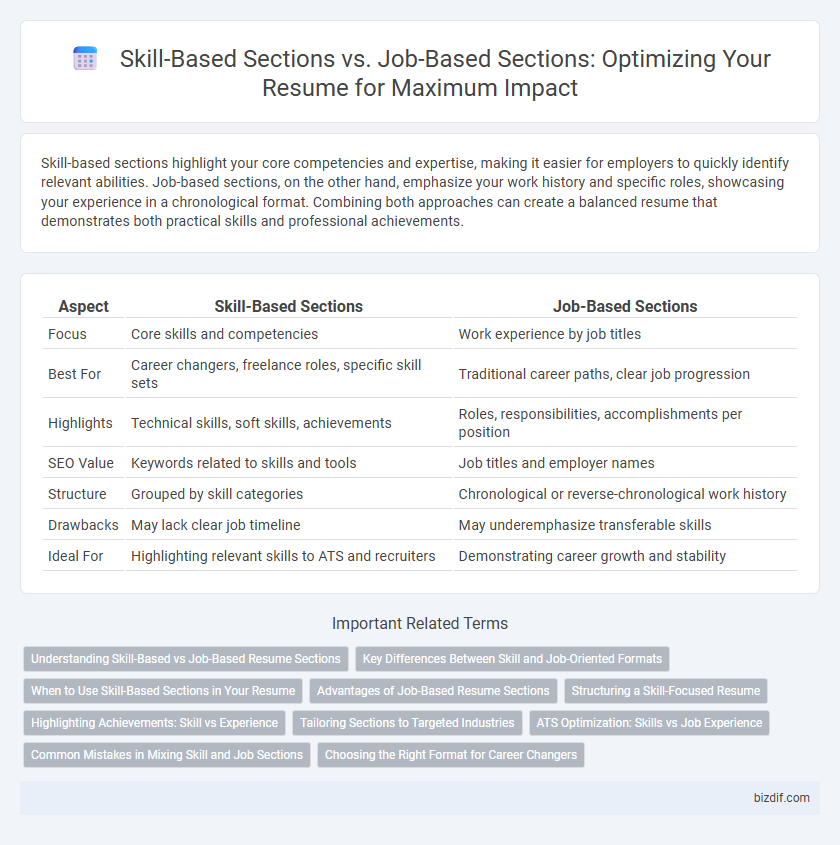Skill-based sections highlight your core competencies and expertise, making it easier for employers to quickly identify relevant abilities. Job-based sections, on the other hand, emphasize your work history and specific roles, showcasing your experience in a chronological format. Combining both approaches can create a balanced resume that demonstrates both practical skills and professional achievements.
Table of Comparison
| Aspect | Skill-Based Sections | Job-Based Sections |
|---|---|---|
| Focus | Core skills and competencies | Work experience by job titles |
| Best For | Career changers, freelance roles, specific skill sets | Traditional career paths, clear job progression |
| Highlights | Technical skills, soft skills, achievements | Roles, responsibilities, accomplishments per position |
| SEO Value | Keywords related to skills and tools | Job titles and employer names |
| Structure | Grouped by skill categories | Chronological or reverse-chronological work history |
| Drawbacks | May lack clear job timeline | May underemphasize transferable skills |
| Ideal For | Highlighting relevant skills to ATS and recruiters | Demonstrating career growth and stability |
Understanding Skill-Based vs Job-Based Resume Sections
Skill-based sections emphasize specific competencies like communication, leadership, and technical abilities, highlighting transferable skills regardless of previous job titles. Job-based sections organize experience chronologically, detailing roles and responsibilities within each position to demonstrate career progression. Understanding the distinction helps tailor resumes to match job descriptions by showcasing either relevant skills or direct job experience.
Key Differences Between Skill and Job-Oriented Formats
Skill-based resume sections highlight specific abilities and expertise tailored to the job requirements, emphasizing transferable skills such as leadership, communication, or technical proficiency. Job-based sections organize experience chronologically by employer, detailing roles, responsibilities, and achievements to demonstrate career progression and industry experience. Skill-oriented formats suit candidates with diverse backgrounds or career changes, while job-based formats benefit those with consistent, relevant work history.
When to Use Skill-Based Sections in Your Resume
Skill-based sections in a resume are most effective for candidates with diverse experiences or those changing careers, as they highlight transferable abilities over specific job roles. These sections emphasize core competencies such as project management, technical proficiency, or communication skills that align with the job description. Use skill-based sections to showcase adaptability and relevant expertise when professional history is varied, limited, or gaps exist.
Advantages of Job-Based Resume Sections
Job-based resume sections highlight specific roles and achievements, allowing recruiters to quickly assess relevant experience across various positions. This format effectively demonstrates career progression and expertise within targeted industries or job functions. Employers often prefer job-based sections for their clear, chronological presentation of responsibilities and accomplishments.
Structuring a Skill-Focused Resume
Structuring a skill-focused resume emphasizes categorizing professional abilities over listing job titles, highlighting transferable skills relevant to the target role. This approach improves keyword optimization for applicant tracking systems by aligning skills with industry-specific terminology. Organizing sections by skill clusters--such as technical proficiency, leadership, and communication--enhances readability and demonstrates versatility across different job functions.
Highlighting Achievements: Skill vs Experience
Skill-based sections emphasize specific competencies and technical abilities, allowing recruiters to quickly identify relevant expertise, while job-based sections focus on professional experience and chronological achievements that demonstrate career progression. Highlighting achievements in skill-based resumes involves quantifying accomplishments directly related to particular skills, such as increased sales percentages or successful project completions, whereas job-based resumes prioritize overall contributions within previous roles and organizational impact. Combining both approaches can effectively showcase a candidate's proficiency and practical experience, enhancing the resume's appeal to diverse hiring managers.
Tailoring Sections to Targeted Industries
Skill-based sections emphasize competencies like project management, data analysis, and technical proficiency tailored to the demands of specific industries such as IT, healthcare, or finance. Job-based sections highlight relevant previous roles and responsibilities, aligning work experience precisely with the targeted industry's requirements. Customizing these sections ensures recruiters quickly identify key qualifications that match industry standards and job descriptions.
ATS Optimization: Skills vs Job Experience
Skill-based resume sections improve ATS optimization by incorporating relevant keywords that align with job descriptions, increasing the likelihood of passing automated screening. Job-based sections highlight concrete accomplishments and experience but may lack the targeted keyword density needed for ATS algorithms. Integrating both skill-based keywords and detailed job experiences creates a balanced resume that appeals to ATS systems and human recruiters alike.
Common Mistakes in Mixing Skill and Job Sections
Common mistakes in mixing skill-based and job-based sections include redundancy, where the same information is repeated in both sections, leading to a cluttered resume. Overlapping content can confuse recruiters, making it hard to distinguish specific competencies from job responsibilities. Properly separating skills from job experiences enhances clarity and highlights core abilities relevant to the job application.
Choosing the Right Format for Career Changers
Skill-based sections highlight transferable abilities and achievements, making them ideal for career changers seeking to emphasize relevant competencies over specific job titles. Job-based sections emphasize work history and chronological experience, which may undersell skills acquired outside traditional roles for those pivoting careers. Selecting a hybrid format balances showcasing key skills while providing employment context, optimizing resume impact for career transition success.
Skill-based sections vs job-based sections Infographic

 bizdif.com
bizdif.com